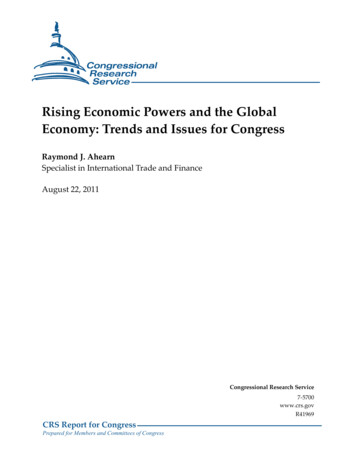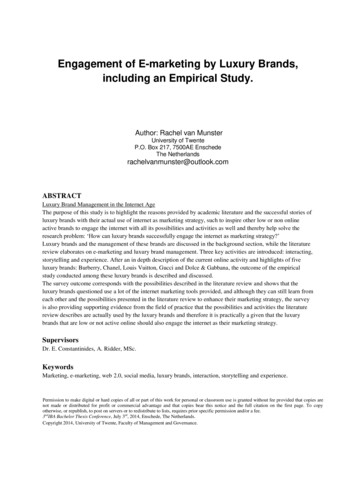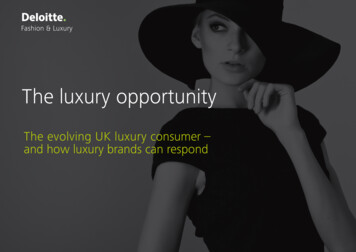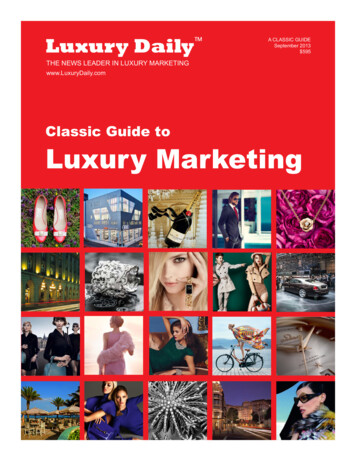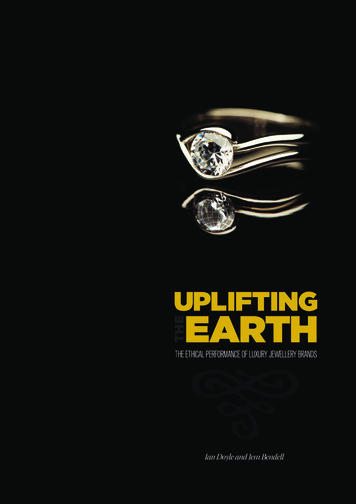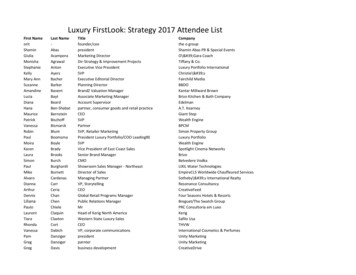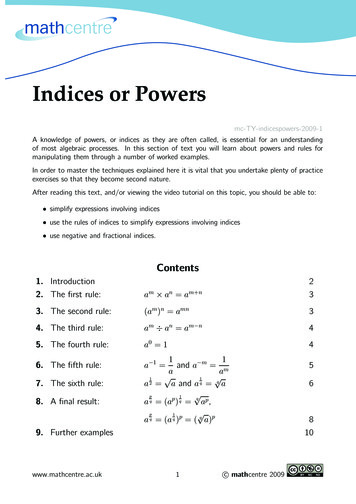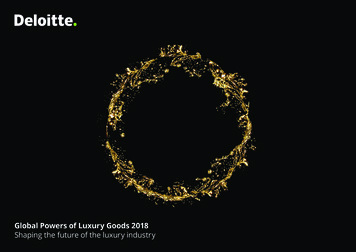
Transcription
Global Powers of Luxury Goods 2018Shaping the future of the luxury industry
ContentsForeword3Top 100 quick statistics4Shaping the future of the luxury industry5Global Economic Outlook9Top 100 highlights13Global Powers of Luxury Goods Top 10015Top 10 highlights23Fastest 2027Product sector analysis29Geographic analysis37Newcomers45Study methodology and data sources47Endnotes50Contacts51Luxury goods in this report focuses on luxury for personal use, and is the aggregation of designerclothing and footwear (ready-to-wear), luxury bags and accessories (including eyewear), luxuryjewellery and watches and premium cosmetics and fragrances.
ForewordWelcome to the fifth Global Powers of Luxury Goods.The report examines and lists the 100 largest luxury goods companies globally, based on the consolidated sales of luxury goods in FY2016 (which we define asfinancial years ending within the 12 months to 30 June 2017). It also discusses the key trends shaping the luxury market and provides a global economic outlook.The world’s 100 largest luxury goods companies generated personal luxury goods sales of US 217 billion in FY2016. At constant currency, the growth rate was1 per cent, 5.8 percentage points lower than the 6.8 per cent currency-adjusted growth achieved by these companies in the previous year. The average luxurygoods annual sales for a Top 100 company is now US 2.2 billion.The luxury market has bounced back from economic uncertainty and geopolitical crises, edging closer to annual sales of US 1 trillion at the end of 2017. Therewere major winners and losers within the Top 100: 57 companies increased their luxury goods sales year-over-year, with 22 achieving double-digit growth, andnearly one-third of the Top 100 achieved a higher rate of sales growth in FY2016 than in FY2015. Growth among the Top 100 was dragged down in particular bythe ten companies suffering a doubledigit sales decline in FY2016, including two Top 10 players - Swatch Group and Ralph Lauren. However, FY2016 seems tomark the bottom of the downturn in luxury goods sales growth for most companies.Key findings from the report include: Italy is once again the leading luxury goods country in terms of number of companies, while companies based in France have the highest share of sales. Cosmetics and fragrances was the top-performing sector in FY2016, and the only sector with improving composite luxury goods sales growth, at 7.6 per cent. The eleven multiple luxury goods companies have by far the largest average size among the Top 100. Their average annual luxury goods sales in FY2016 wereUS 6.3 billion, and together they accounted for 32.2 per cent of the Top 100 luxury goods sales.We hope you find this report interesting and useful, and welcome your feedback.Patrizia ArientiEMEA Fashion & Luxury LeaderDeloitte Touche Tohmatsu Limited3Global Powers of Luxury Goods 2018
Top 100 quick statisticsComposite year-overyear Top 100 luxurygoods sales growth1.0%Average luxurygoods sales ofTop 100 companiesUS 2.2billionComposite8.8%Global Powers of Luxury Goods 2018Aggregate netluxury goods salesof Top 100US 217Compositereturn onassets6.9%billionEconomicconcentrationof Top 10Minimum salesrequired to be onTop 100 listUS 211million47.2%FY2014-16Compound annualgrowth rate in luxurygoods sales3.9%Compositeasset turnover0.8x4
Shaping the future of the luxury industryThe luxury goods industry has faced anumber of changes over the past twodecades. Currently, varying economictrends, rapid digital transformation andevolving consumer preferences andtastes are creating a new competitivelandscape where traditional corporatestrategies are under threat.Whether total global market growth isin single or double digits will dependon many factors, including largergeopolitical factors and their impact ontourism. Even so, growth in the luxurygoods industry will continue, unlike inseveral other industries.However, to return to a steady andsolid rate of sales growth, luxuryplayers have to face up to newchallenges and deal with them in adecisive way.5Will Europe, the US, China and Japancontinue to dominate the luxury goodsindustry?The supply chain and retail network for the luxury goodsindustry have spread globally. However, Europe and the UShave continued to account for a disproportionate share ofsales. Although historically the industry has operated on a"West versus the Rest" basis, recent trends underline thegrowing importance of Asia, the Middle East, Latin Americaand Africa.Total sales of clothing and footwear in Europe and NorthAmerica will fall from more than 50 per cent of the globalmarket in 2017 less than half in 2018, while sales in Asia, LatinAmerica, the Middle East and Africa combined will rise above50 per cent and continue to increase in subsequent years.Most industry observers attribute this development not justto growing sales in emerging markets, but also to innovativeretail concepts and business models adopted in theseregions.The growing importance of non-western markets for theluxury goods industry has been supported by supply chainleadership, technological innovation and internationalinvestment. These factors will help maintain further stronggrowth in these geographical markets.Luxury brands have refocused their business strategies tocapitalise on these changes. For example, Giorgio Armani isengaged in an in-store installation collaboration agreementwith Colombian artist Marta Luz Gutiérrez, while LouisVuitton is conducting an advertising campaign using abuilding designed by the late Mexican architect Luis Barragán.Rising prosperity in major cities and growing formal marketpower over the black market will ensure sustained Rest ofthe World (ROW) demand for luxury goods. To succeed inthis context, luxury players should focus their investmentson digital connectivity, upwardly mobile consumers andbold business models, which are key components of thepersonal luxury industry today.Case 1 - GucciIn 2017, Gucci's ecommerce sales rose by 86per cent. Millennials accounted for about 50per cent of revenues. Total Gucci brand salesincreased by 42 per cent to 6.2 billion.1Growth reflected synergies from the brand'sreinvention for millennial customers (knownas "geek-chic") and its online experience.Gucci’s omnichannel integration of its onlineand in-store brand experience helped it winL2's Digital IQ Index: Fashion US in both 2016and 2017.2Also, the company launched its boutiquesmodelled under the "New Store Concept" in2015, integrating online and in-store shoppingexperiences.Further, in 2017 Gucci launched online stores in keymarkets such as China and the Middle East. They alsolaunched a re-designed website in October 2016,providing visual presentations and stories, and offeringpersonalised customer service by webchat, e-mail andphone. For their spring/summer 2018 collection, Gucci’sflagship stores became interactive art galleries. Thecompany has also introduced a new digital campaignfor its spring 2018 collection, featuring scannable ads,and augmented and virtual reality experiences.3Global Powers of Luxury Goods 2018
Will digital techniques such as AR and AIhelp independent luxury brands competewith large groups?The internet has become an integral part of the purchasinghabits of various groups of consumers worldwide. Howevercurrently, luxury sales growth is being driven by millennialsand Generation Z. With different expectations, youngershoppers seek a personalised shopping experience thatseamlessly integrates both online and offline platforms.This shift has motivated demand for connective technologysuch as Augmented Reality (AR) and Artificial Intelligence(AI). By using AR and AI technologies, luxury brands canprovide a personalised consumer experience, reach a wideraudience, deepen product experience, and build strongercustomer relationships. In parallel, the development oftechnologies such as voice commerce and the Internet ofThings (IoT) are reshaping the entire luxury industry.Luxury brands positioned as reliable sources of AI-drivenrecommendations are improving how they engage withconsumers. More widespread adoption of AI is also makingconsumers increasingly reliant on suggestions and adviceprovided by their various devices, rather than makingdecisions based on personal experience. In January 2018,Estée Lauder-owned Smashbox Cosmetics launched itsfirst Messenger bot for UK customers to help explore newproducts, read usage instructions, and locate the neareststocked store. In December 2017, LVMH launched a "virtualadviser" on Facebook Messenger for US clients. The chatbotanswers queries relating to Louis Vuitton products, such assearching the brand’s online catalogue, detailing the brand’shistory, and providing advice on product maintenance.Global Powers of Luxury Goods 2018Further, luxury brands are also using AR in combinationwith their physical retail stores to enhance the shoppingexperience of their customers. This technology helpsconsumers visualise and "try" new products at home beforemaking a purchase. For example, in July 2017 Estée Lauderannounced the launch of a conversational AR lipstick advisorthat helps potential customers identify their ideal lip shade.L’Oréal is increasingly focusing on AR to enhance customerexperience: in March 2018 they acquired ModiFace, aninternationally recognised leader in AR and AI applicationsused by the beauty industry. YOOX's "Try, Share and Shop"initiative partnered with Lumyer in 2017 to produce an ARcamera app that enables users to try handbags, sunglassesand jewelry from YOOX in virtual reality. Burberry has usedARkit by Apple as part of its digital marketing strategy throughimmersive story-telling.So far, relatively few personal luxury brands have used ARapps, with the most widespread use taking place in themakeup sector. The adoption of the AI- and AR-driventechnology for the whole luxury sector is not so fast asthe market was expecting, because the larger playershave complex cost structures and the return on thesetechnologies could not outweigh the cost of investment inthem. Despite this, big luxury groups should be awareof digital transformation in retail technology, which ischanging how affluent consumers shop and driving growth ofindependent luxury brands.How does the millennial state-ofmind and loyalty towards personalluxury goods affect the industry andcommunications and sales strategies ofluxury brands?Luxury goods industry sales growth and profitability haveunderperformed in recent years, partly because of itsproblems in adjusting to changed demographics. The sectorhas lagged other consumer industries in recognising theincreasing purchasing power of ely millennials and Generation Z will representmore than 40 per cent of the overall luxury goods marketby 2025, compared with around 30 per cent in 2016.Unlike Baby Boomers, many millennial luxury consumersexpect to interact with brands across a range of digitalplatforms, rather than only through traditional channels.Millennial consumers are also important for in-storeshopping and expect a high-value, customised experience.Luxury brands should seek to change their business modelsto meet this demand, for example by providing more loyaltyprogrammes and invitations to in-store events.Further, for millennials the emotional and personal contextwithin which luxury brands appeal to consumers has widenedconsiderably. Luxury brands are supplementing traditionalattributes such as quality and scarcity with lifestyle valuesincluding sustainability to attract millennial consumers. Theemphasis on sustainability is visible in many areas especiallyin advertisements. Luxury brands have begun to highlighttheir use of renewable and organic materials, and nowemphasise their efforts to lessen the environmental impact oftheir production.6
The future success of the industry will depend on itssuccess in permeating and proactively reaching out to theyounger generation. A good communication strategy can bea lever.Historically, in terms of communication, luxury fashionbrands have based their identity on exclusivity, prestige andimpeccable service, retaining a dignified distance betweenthemselves and their customers. However, as sales haveslowed, they have been compelled to engage with consumersvia social media.Luxury brands previously viewed social media as "massmarket", but today it has become an increasingly importantmarketing tool for them.Burberry is an excellent example of a luxury brand thatrealised early on the power and influence of social media.According to an article on SocialWall, the brand dedicatesaround 60 per cent of its marketing budget to digitalplatforms, engaging customers on Facebook, Twitter, Tumblr,Pinterest, Instagram and YouTube.In recent years, luxury brands have engaged with moreconsumers on social media through digital marketing andweb listening data analytics to gain insights into customerbehavior. Instagram is emerging as the leading social mediaplatform for fashion designers. Gucci more than doubledits Instagram followers between 2016 and March 2018, withsuccessful Insta-campaigns such as #TFWGucci.In future, the biggest challenge for luxury brands willbe to make optimum use of social media withoutcompromising their brand values. The success of a socialmedia strategy will be converting "likes" into an interactiveand engaging experience for customers.Followers of Luxury Brands on Social Media (millions),as at March 19, 2018BrandsLouis VuittonGucciDiorD&GPradaCalvin KleinVersaceBurberryRalph 35.58.35.31.03.64.58.62.3Case 2 - FarfetchFarfetch plans to launch a new technologicalapplication, to revolutionise in-store shopping.4Unveiled in April 2017, "Store of the Future"forms part of the firm’s Augmented Retailstrategy, to connect online and offlineretail activities.By focusing on individual human traitsand other behav
ARkit by Apple as part of its digital marketing strategy through immersive story-telling. So far, relatively few personal luxury brands have used AR apps, with the most widespread use taking place in the makeup sector. The adoption of the AI- and AR-driven technology for the whole luxury sector is
